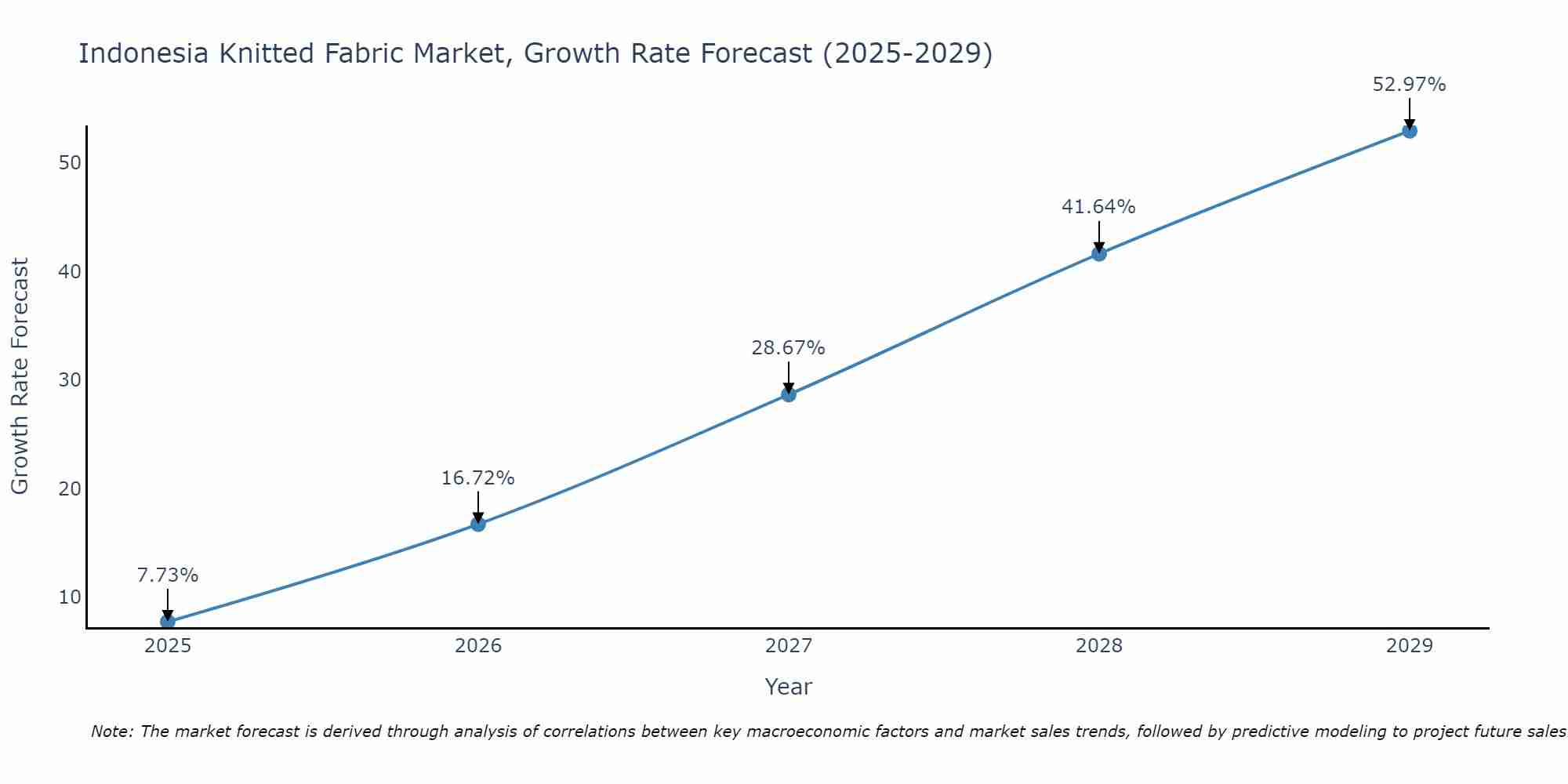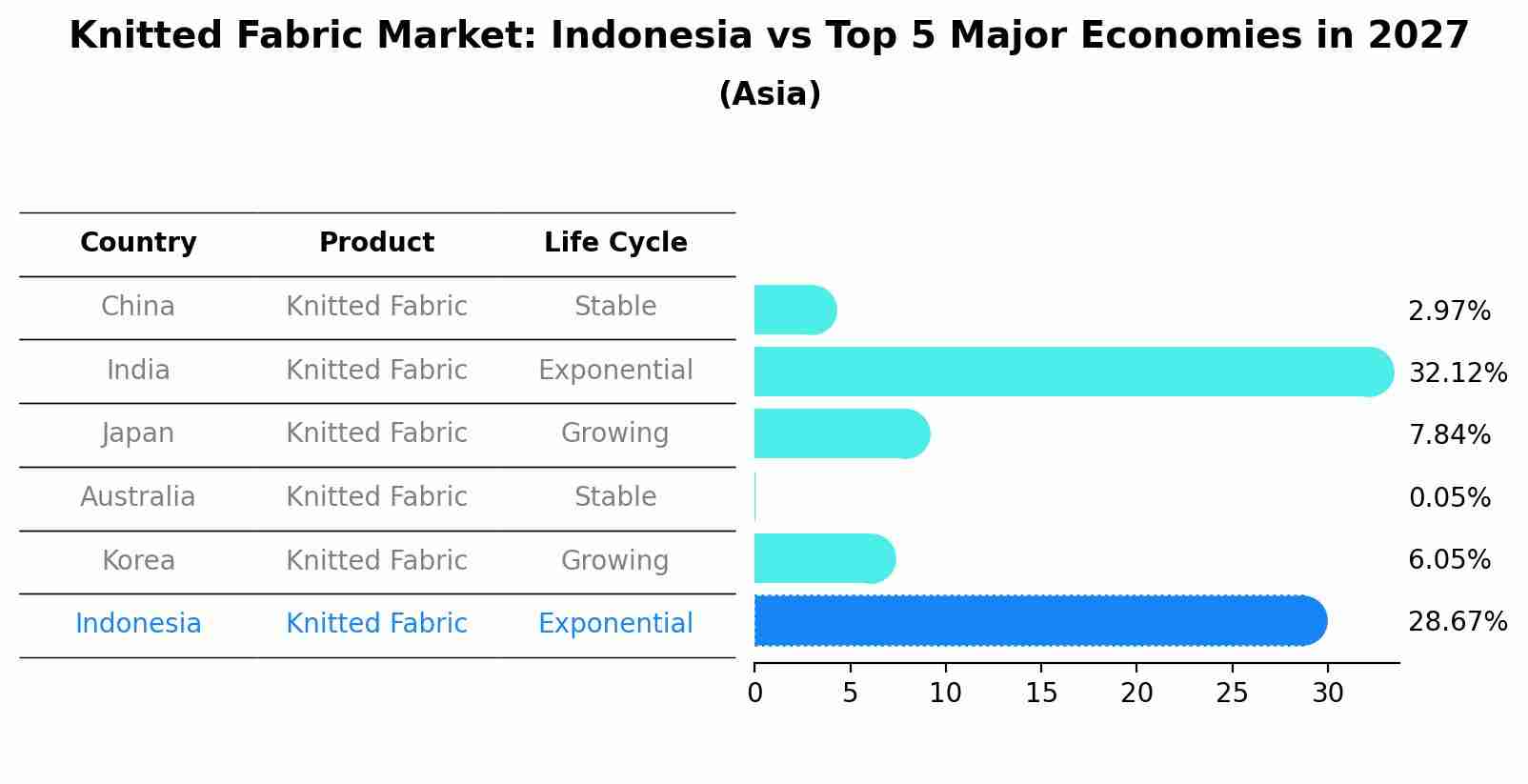Indonesia Knitted Fabric Market (2024-2030) | Growth, Value, Revenue, Outlook, Forecast, Trends, Industry, Companies, Size, Share, Analysis
| Product Code: ETC036408 | Publication Date: Jul 2023 | Updated Date: Aug 2025 | Product Type: Report | |
| Publisher: 6Wresearch | No. of Pages: 70 | No. of Figures: 35 | No. of Tables: 5 | |
Indonesia Knitted Fabric Market Size Growth Rate
The Indonesia Knitted Fabric Market is likely to experience consistent growth rate gains over the period 2025 to 2029. Commencing at 7.73% in 2025, growth builds up to 52.97% by 2029.

Knitted Fabric Market: Indonesia vs Top 5 Major Economies in 2027 (Asia)
By 2027, the Knitted Fabric market in Indonesia is anticipated to reach a growth rate of 28.67%, as part of an increasingly competitive Asia region, where China remains at the forefront, supported by India, Japan, Australia and South Korea, driving innovations and market adoption across sectors.

Indonesia Knitted Fabric Market Synopsis
The Indonesia knitted fabric market is expected to witness a significantduring theperiod of 2020-2026. Thiscan be attributed to increasing demand for fashionable knitwear products in Indonesia rising disposable income and growing population. Additionally manufacturers are continuously investing in advanced technologies in order to produce better quality fabrics at lower costs. Moreover various foreignhave been making investments in Indonesia`s textiles and appareldue to its low cost labor force and abundant resources available for production. Furthermore the development of e-commerce platforms has made it easier for consumers across the country to purchase knitted fabrics online conveniently from anywhere at any time leading boosting the overall market .
Key Factors Driving the Market
The demand for fashionable knitwear products such as tracksuits cardigans hoodies etc. is increasing significantly among consumers across all age groups which is driving theof knitted fabric market in Indonesia. The disposable incomes of Indonesia households have increased over recent years due to economic development and a rise in employment opportunities which has enabled them to spend more on luxury items such as branded clothing which further drives up the demand for high quality fabrics like knits thus pushing up sales volumes within this sector. With an estimated population close 5 million people the country?s burgeoning population provides ample scope for potential customers who will drive consumption levels upward .This factor also contributes largely towards fuelling domestic consumption levels across different sectors including textile .
Challenges Facing the Market
Producing knitted fabric requires a large amount of capital investment owing mainly due poor infrastructure facilities like a shortage of power supply or lack of modern machinery that increases production costs hence decreasing profits margins considerably.Also strict environmental norms imposed by government agencies add extra burden to manufacturers while trying to operate profitably.The majority local producers resort to producing low-quality cheap materials cutting corners thereby affecting the integrity final product leading dissatisfied customers who look for alternatives elsewhere and adding woes to already struggling players in this segment.
Key Market Players
Some key players operating within Indonesia knitted fabric space include PT Argo Pantes Tbk (APTA) PT Wijayakusuma Textile Industries (WITEX) PT Jaya Gunasindo Texmaco (JGT) KINIYUN INDONESIA Ltd.PT Pan.
Key Highlights of the Report:
- Indonesia Knitted Fabric Market Outlook
- Market Size of Indonesia Knitted Fabric Market, 2023
- Forecast of Indonesia Knitted Fabric Market, 2030
- Historical Data and Forecast of Indonesia Knitted Fabric Revenues & Volume for the Period 2020-2030
- Indonesia Knitted Fabric Market Trend Evolution
- Indonesia Knitted Fabric Market Drivers and Challenges
- Indonesia Knitted Fabric Price Trends
- Indonesia Knitted Fabric Porter's Five Forces
- Indonesia Knitted Fabric Industry Life Cycle
- Historical Data and Forecast of Indonesia Knitted Fabric Market Revenues & Volume By Construction Type for the Period 2020-2030
- Historical Data and Forecast of Indonesia Knitted Fabric Market Revenues & Volume By Weft for the Period 2020-2030
- Historical Data and Forecast of Indonesia Knitted Fabric Market Revenues & Volume By Wrap for the Period 2020-2030
- Historical Data and Forecast of Indonesia Knitted Fabric Market Revenues & Volume By Fabrics Type for the Period 2020-2030
- Historical Data and Forecast of Indonesia Knitted Fabric Market Revenues & Volume By Flat/Jersey for the Period 2020-2030
- Historical Data and Forecast of Indonesia Knitted Fabric Market Revenues & Volume By Purl for the Period 2020-2030
- Historical Data and Forecast of Indonesia Knitted Fabric Market Revenues & Volume By Rib Stitch for the Period 2020-2030
- Historical Data and Forecast of Indonesia Knitted Fabric Market Revenues & Volume By Interlock for the Period 2020-2030
- Indonesia Knitted Fabric Import Export Trade Statistics
- Market Opportunity Assessment By Construction Type
- Market Opportunity Assessment By Fabrics Type
- Indonesia Knitted Fabric Top Companies Market Share
- Indonesia Knitted Fabric Competitive Benchmarking By Technical and Operational Parameters
- Indonesia Knitted Fabric Company Profiles
- Indonesia Knitted Fabric Key Strategic Recommendations
Frequently Asked Questions About the Market Study (FAQs):
1 Executive Summary |
2 Introduction |
2.1 Key Highlights of the Report |
2.2 Report Description |
2.3 Market Scope & Segmentation |
2.4 Research Methodology |
2.5 Assumptions |
3 Indonesia Knitted Fabric Market Overview |
3.1 Indonesia Country Macro Economic Indicators |
3.2 Indonesia Knitted Fabric Market Revenues & Volume, 2020 & 2030F |
3.3 Indonesia Knitted Fabric Market - Industry Life Cycle |
3.4 Indonesia Knitted Fabric Market - Porter's Five Forces |
3.5 Indonesia Knitted Fabric Market Revenues & Volume Share, By Construction Type, 2020 & 2030F |
3.6 Indonesia Knitted Fabric Market Revenues & Volume Share, By Fabrics Type, 2020 & 2030F |
4 Indonesia Knitted Fabric Market Dynamics |
4.1 Impact Analysis |
4.2 Market Drivers |
4.2.1 Growing demand for sustainable and eco-friendly fabrics in Indonesia |
4.2.2 Increasing adoption of knitted fabrics in the fashion industry |
4.2.3 Rise in disposable income leading to higher spending on clothing and textiles |
4.3 Market Restraints |
4.3.1 Fluctuating raw material prices impacting production costs |
4.3.2 Intense competition from other textile manufacturing countries |
4.3.3 Challenges in maintaining consistent quality standards across the industry |
5 Indonesia Knitted Fabric Market Trends |
6 Indonesia Knitted Fabric Market, By Types |
6.1 Indonesia Knitted Fabric Market, By Construction Type |
6.1.1 Overview and Analysis |
6.1.2 Indonesia Knitted Fabric Market Revenues & Volume, By Construction Type, 2020-2030F |
6.1.3 Indonesia Knitted Fabric Market Revenues & Volume, By Weft , 2020-2030F |
6.1.4 Indonesia Knitted Fabric Market Revenues & Volume, By Wrap, 2020-2030F |
6.2 Indonesia Knitted Fabric Market, By Fabrics Type |
6.2.1 Overview and Analysis |
6.2.2 Indonesia Knitted Fabric Market Revenues & Volume, By Flat/Jersey, 2020-2030F |
6.2.3 Indonesia Knitted Fabric Market Revenues & Volume, By Purl , 2020-2030F |
6.2.4 Indonesia Knitted Fabric Market Revenues & Volume, By Rib Stitch, 2020-2030F |
6.2.5 Indonesia Knitted Fabric Market Revenues & Volume, By Interlock , 2020-2030F |
7 Indonesia Knitted Fabric Market Import-Export Trade Statistics |
7.1 Indonesia Knitted Fabric Market Export to Major Countries |
7.2 Indonesia Knitted Fabric Market Imports from Major Countries |
8 Indonesia Knitted Fabric Market Key Performance Indicators |
8.1 Percentage of knitted fabric made from sustainable materials |
8.2 Adoption rate of knitted fabrics in new clothing collections |
8.3 Number of new entrants or expansions in the knitted fabric manufacturing sector |
9 Indonesia Knitted Fabric Market - Opportunity Assessment |
9.1 Indonesia Knitted Fabric Market Opportunity Assessment, By Construction Type, 2020 & 2030F |
9.2 Indonesia Knitted Fabric Market Opportunity Assessment, By Fabrics Type, 2020 & 2030F |
10 Indonesia Knitted Fabric Market - Competitive Landscape |
10.1 Indonesia Knitted Fabric Market Revenue Share, By Companies, 2023 |
10.2 Indonesia Knitted Fabric Market Competitive Benchmarking, By Operating and Technical Parameters |
11 Company Profiles |
12 Recommendations |
13 Disclaimer |
- Single User License$ 1,995
- Department License$ 2,400
- Site License$ 3,120
- Global License$ 3,795
Search
Related Reports
- ASEAN Bearings Market (2025-2031) | Strategy, Consumer Insights, Analysis, Investment Trends, Opportunities, Growth, Size, Share, Industry, Revenue, Segments, Value, Segmentation, Supply, Forecast, Restraints, Outlook, Competition, Drivers, Trends, Demand, Pricing Analysis, Competitive, Strategic Insights, Companies, Challenges
- Europe Flooring Market (2025-2031) | Outlook, Share, Industry, Trends, Forecast, Companies, Revenue, Size, Analysis, Growth & Value
- Saudi Arabia Manlift Market (2025-2031) | Outlook, Size, Growth, Trends, Companies, Industry, Revenue, Value, Share, Forecast & Analysis
- Uganda Excavator, Crane, and Wheel Loaders Market (2025-2031) | Strategy, Consumer Insights, Analysis, Investment Trends, Opportunities, Growth, Size, Share, Industry, Revenue, Segments, Value, Segmentation, Supply, Forecast, Restraints, Outlook, Competition, Drivers, Trends, Demand, Pricing Analysis, Competitive, Strategic Insights, Companies, Challenges
- Rwanda Excavator, Crane, and Wheel Loaders Market (2025-2031) | Strategy, Consumer Insights, Analysis, Investment Trends, Opportunities, Growth, Size, Share, Industry, Revenue, Segments, Value, Segmentation, Supply, Forecast, Restraints, Outlook, Competition, Drivers, Trends, Demand, Pricing Analysis, Competitive, Strategic Insights, Companies, Challenges
- Kenya Excavator, Crane, and Wheel Loaders Market (2025-2031) | Strategy, Consumer Insights, Analysis, Investment Trends, Opportunities, Growth, Size, Share, Industry, Revenue, Segments, Value, Segmentation, Supply, Forecast, Restraints, Outlook, Competition, Drivers, Trends, Demand, Pricing Analysis, Competitive, Strategic Insights, Companies, Challenges
- Angola Excavator, Crane, and Wheel Loaders Market (2025-2031) | Strategy, Consumer Insights, Analysis, Investment Trends, Opportunities, Growth, Size, Share, Industry, Revenue, Segments, Value, Segmentation, Supply, Forecast, Restraints, Outlook, Competition, Drivers, Trends, Demand, Pricing Analysis, Competitive, Strategic Insights, Companies, Challenges
- Israel Intelligent Transport System Market (2025-2031) | Strategy, Consumer Insights, Analysis, Investment Trends, Opportunities, Growth, Size, Share, Industry, Revenue, Segments, Value, Segmentation, Supply, Forecast, Restraints, Outlook, Competition, Drivers, Trends, Demand, Pricing Analysis, Competitive, Strategic Insights, Companies, Challenges
- Uganda Precast and Aggregate Market (2025-2031) | Strategy, Consumer Insights, Analysis, Investment Trends, Opportunities, Growth, Size, Share, Industry, Revenue, Segments, Value, Segmentation, Supply, Forecast, Restraints, Outlook, Competition, Drivers, Trends, Demand, Pricing Analysis, Competitive, Strategic Insights, Companies, Challenges
- Australia IT Asset Disposal Market (2025-2031) | Strategy, Consumer Insights, Analysis, Investment Trends, Opportunities, Growth, Size, Share, Industry, Revenue, Segments, Value, Segmentation, Supply, Forecast, Restraints, Outlook, Competition, Drivers, Trends, Demand, Pricing Analysis, Competitive, Strategic Insights, Companies, Challenges
Industry Events and Analyst Meet
Our Clients
Whitepaper
- Middle East & Africa Commercial Security Market Click here to view more.
- Middle East & Africa Fire Safety Systems & Equipment Market Click here to view more.
- GCC Drone Market Click here to view more.
- Middle East Lighting Fixture Market Click here to view more.
- GCC Physical & Perimeter Security Market Click here to view more.
6WResearch In News
- Doha a strategic location for EV manufacturing hub: IPA Qatar
- Demand for luxury TVs surging in the GCC, says Samsung
- Empowering Growth: The Thriving Journey of Bangladesh’s Cable Industry
- Demand for luxury TVs surging in the GCC, says Samsung
- Video call with a traditional healer? Once unthinkable, it’s now common in South Africa
- Intelligent Buildings To Smooth GCC’s Path To Net Zero













